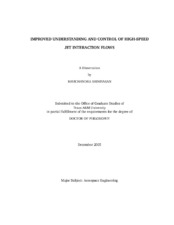| dc.contributor.advisor | Bowersox, Rodney D. W. | |
| dc.creator | Srinivasan, Ravichandra | |
| dc.date.accessioned | 2006-04-12T16:01:36Z | |
| dc.date.available | 2006-04-12T16:01:36Z | |
| dc.date.created | 2005-12 | |
| dc.date.issued | 2006-04-12 | |
| dc.identifier.uri | https://hdl.handle.net/1969.1/3055 | |
| dc.description.abstract | A numerical study of the flow field generated by injection through diamondshaped
orifices into a high-speed flow is presented in this document. Jet interaction
flows have a wide range of applications in the field of engineering. These
applications include the use of jets for fuel injection in scramjets, for reaction control
of high-speed aerodynamic bodies and as cooling jets for skins of high-speed
vehicles. A necessary requirement in the use of transverse jets for these and other
applications is a thorough understanding of the physics of the interaction between
the jet and freestream. This interaction generates numerous flow structures that
include multiple shocks, vortices, recirculation regions and shear layers. This study
involves diamond-shaped orifices that have the advantage of generating weaker or
attached interaction shocks as compared to circular injectors. These injectors also
negate the effects due to the recirculation region that is formed upstream of the
injector. This study was undertaken in order to gain further understanding of the
flow features generated by diamond-shaped injectors in a high-speed flow.
Numerical simulations were performed using two different levels of turbulence
models. Reynolds™ Averaged Navier-Stokes (RANS) simulations were performed
using the GASP flow solver while Detached-Eddy Simulation (DES) runs were performed
using the Cobalt flow solver. A total of fifteen diamond injector simulations
were performed using the RANS model for a 15 half-angle diamond injector. The fifteen simulations spanned over five different injection angles and three jet total
pressures. In addition to these, two circular injector simulations were also performed.
In addition, low pressure normal injection through diamond and circular
orifices simulations were performed using DES. Results obtained from CFD were
compared to available experimental data. The resulting flow structure and the turbulent
properties of the flow were examined in detail. The normal injection case
through the diamond-shaped orifice at the lowest jet total pressure was defined
as the baseline case and is presented in detail. In order to study the effect of different
components of the vorticity transport equation, an in-house code was used
post-process the results from the RANS runs. | en |
| dc.format.extent | 6744750 bytes | en |
| dc.format.medium | electronic | en |
| dc.format.mimetype | application/pdf | |
| dc.language.iso | en_US | |
| dc.publisher | Texas A&M University | |
| dc.subject | Transverse Jet Interaction | en |
| dc.subject | Hypersonic Flow | en |
| dc.subject | Diamond Injectors | en |
| dc.subject | Detached-Eddy Simulation | en |
| dc.title | Improved understanding and control of high-speed jet interaction flows | en |
| dc.type | Book | en |
| dc.type | Thesis | en |
| thesis.degree.department | Aerospace Engineering | en |
| thesis.degree.discipline | Aerospace Engineering | en |
| thesis.degree.grantor | Texas A&M University | en |
| thesis.degree.name | Doctor of Philosophy | en |
| thesis.degree.level | Doctoral | en |
| dc.contributor.committeeMember | Cizmas, Paul | |
| dc.contributor.committeeMember | Girimaji, Sharath | |
| dc.contributor.committeeMember | North, Simon | |
| dc.type.genre | Electronic Dissertation | en |
| dc.type.material | text | en |
| dc.format.digitalOrigin | born digital | en |


